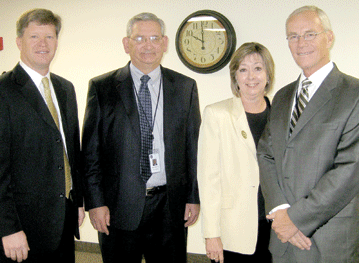- State Superintendent of Public Instruction told Juab School District officials that Utah leads the nation in spending the least to achieve the most
|

VISITING OUR SCHOOLS • Left to Right: Jim Shank, Juab School District Superintendent; Martell Menlove, Utah State Associate Superintendent of Public Instruction; Janet Ware, Principal of Red Cliffs Elementary; Dr. Larry K. Shumway, Utah State Superintendent of Public Instruction during a visit to the Juab School District Schools, last week.
By Myrna Trauntvein
Times-News Correspondent
It costs $3 million per hour to operate public schools in Utah but public education gets a lot of bang for its buck.
That was one of the facts presented by Dr. Larry K. Shumway, State Superintendent of Public Instruction, when he and Martell Menlove, Associate Superintendent of Public Instruction, visited Juab School District on Wednesday.
Shumway began his remarks by stating that he and local educator, Paul Messersmith, began their educational careers together in Snowflake, Arizona, in 1979 and had been friends ever since.
Menlove, graduated from Juab High School and was the son of a former Juab School District Superintendent, Ralph Menlove.
Parents need to be fully engaged in their children's education, said Shumway.
"I'm asking parents to read to their children," he said. "I'm asking parents to spend time with their children on their schoolwork. I'm asking parents to communicate with teachers by attending parent-teacher conferences."
Shumway met with some faculty members, administrators and board members at 10:30 a.m. at the district office in the board room to offer a few remarks before spending the remainder of the day visiting with children and teachers at local schools.
"Imagine the effect on achievement in Utah's schools if every student worked as hard as the hardest working student. Imagine the possibilities if every parent were as engaged as the most engaged parent. The difference between successful students and unsuccessful students is not that successful students are smarter. The difference is that successful students are engaged, committed, and devote time to their studies."
Shumway said that in the state's schools perform what he likes to call "the Utah education miracle."
"In Utah we spend about $6,200 per student, less than any other state," he said.
Utah leads the nation in spending the least to achieve the most.
"We're the national leader in cost management by a large margin. We are nearly 25 percent more efficient than the next closest state, Tennessee. From this perspective, I see our schools in a positive light, as more productive. I see leaders producing results that are above the average, and school boards and charter boards making effective management decisions, all with the lowest administrative overhead in the country."
Education in the state continues to have good results. On the ACT, Utah ranks eighth among states that test more than half their graduates. Utah, he said, has a graduation rate of more than 88 percent making it near the top.
More than 67 percent of students in AP courses pass the exams, while the national average is only 58 percent.
A recent Utah Foundation report compared Utah to six other states: New Jersey, Vermont, New Hampshire, Minnesota, Wyoming, and South Dakota. Student results on some tests trail these states.
"What wasn't reported is that the cost per student in Wyoming and Vermont is more than $16,000; in New Jersey, it's more than $14,000. Our Utah cost of just $6,228 per student is far below these states."
During the summer, said Shumway, he often attended family reunions. At those reunions there was school-bashing by some of his relatives.
"I worry when I see that some are making arguments based on the premise that Utah public schools are failing, or are wasteful, or are poorly managed. Sadly, something repeated often enough begins to be taken as the truth, false though it may be."
Educators should be positive in getting out the good news. Utah schools are the most efficient in the country, and Utah citizens receive the best return on their investment in the country.
The State Board of Education's statement of vision and mission for public education is called "Promises to Keep" the title of which comes from a poem by Robert Frost.
The state must move forward in four key areas: investment of resources; support from businesses and individuals; focus on the vision and mission in "Promises to Keep;" and commitment and engagement by students and parents.
"In 'Promises to Keep' we have defined the work schools must do. It consists of four promises to our citizens: ensuring literacy and numeracy for all children, providing high-quality instruction for all children, establishing curriculum with high standards and relevance for all children, and providing accountability measures to inform students and teachers as well as communities and policymakers," he said.
There were four areas for investment that should be considered: First, early childhood education, expanded kindergarten opportunities, and early grade support. Second, information and communications technology. Third, aligning the curriculum to meet the needs of business and the workforce. Fourth, the state must invest in the professional abilities of teachers.
"The most important school variable in student achievement is the quality of instruction in the classroom," he said.
There is a science of instruction that should be used in every classroom. He said that researchers have found that high-quality classroom instruction can lead to multiple-year student gains in a single year, and poor classroom instruction can create deficits that may take years to fill.
Nearly 600,000 students are enrolled in 1,000 Utah schools, and the state is still growing with 25,000 students added in the past two years.
|